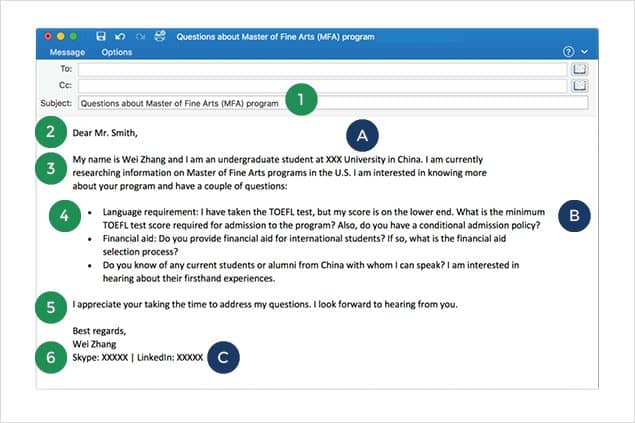Email Etiquette 101 for International Students
Tuesday | July 31, 2018 | by Li Chang

WES research shows that 88 percent of international students check, read, or send emails at least once a day. In fact, during their college search, 62 percent of international students used mobile devices to communicate with admissions staff in the United States. Therefore, email plays an important role in the admissions process. It could be very beneficial for international students to learn about email etiquette in the U.S.
According to Sara Konekeo, the Associate Director for Admission, Data Management and Academic Services at the New School, many students do not follow basic communication etiquette in their emails. She says: “We struggle with the lack of professionalism that has become the norm when students are communicating with us. We do our best to guide students to add a bit more professionalism and traditional etiquette in their correspondence. We don’t want their communication to affect their admissions decision.”
So here’s the question for you: Are you writing clear, effective emails to admissions officers?
This post presents a few tips to improve your email etiquette. You will also find a template you can use when communicating with admissions officers.
Tips for Emailing Admissions Officers
In general, here are the three rules to keep in mind when emailing university admissions officers:
- Keep your email message clear and concise. Admissions officers are busy people. They have to deal with up to hundreds and sometimes even thousands of applications every year. It is important to keep your email brief and to the point.
- Check your spelling, punctuation, and grammar. I know this can be rather difficult to follow as there are many language nuances that non-native English speakers often find hard to comprehend—for example, you may struggle with whether or not to keep a “the” in the sentence, or when to use “a” versus “an.” Although emails are not academic papers, you must do your best to minimize grammar mistakes. If the email provider you use does not come with a built-in spell-checker, write the email draft in Microsoft Word or a similar word processing tool that provides an auto spelling and grammar function. A spell-checker helps correct basic mistakes, such as typos, punctuation errors, and verb tense mistakes. There are also a variety of online proofreaders, such as Grammarly or PaperRater, which may come in handy.
- Keep it professional. Although there are no strict rules when it comes to the type of font and size to use, you should refrain from using multiple colors and dazzling font types, such as Freestyle Script, as they distract from the message. Nonetheless, you may follow the same formatting requirements you would use when writing an essay. For example, the Stanford Graduate School of Business recommends using one of the more common fonts, such as Times New Roman or Arial, in a 12-point font size.
Email Template for Writing to Colleges in the U.S.
The email template above illustrates each numbered guideline and lettered tip below:
- The subject line should clearly identify the topic of the email. Do not leave the subject line blank! You do not want the email provider to categorize your email as spam.
- Start the email by addressing the admissions officer by their full name. If you cannot find who is in charge of admissions, you may use “Dear Admissions Officer” or “To Whom It May Concern.”
- Provide background information and indicate the purpose of the email in the first paragraph.
- Expand your message. You can do this by using bullet points or separate paragraphs for different topics or questions. For example, bullet points help organize thoughts and make for easy reading.
- Close your message with your expectation of the next step(s), if applicable. Do not forget to thank the admissions officer for their time.
- Do not press “Send” without signing your name! At the very least, the admissions officer should know who they are talking to.
Email Etiquette: 3 Final Tips
- 1: Some institutions have a special admissions policy for students from certain countries or schools. Providing this information can help admissions officers better adapt their answer to your particular case.
- 2: Some schools have a conditional admissions policy, which you may want to ask about if your English proficiency test scores are low.
- 3: Indicate how you prefer to be reached after your name at the end of the email. This may include your contact information, such as your phone number or email address, or links to your social media accounts. Nowadays, most institutions are present on social media outlets. You may get a chance to interact with admissions officers directly on social media platforms.
If you are looking for more email writing tips and guidelines, then check out Email Etiquette by the Online Writing Lab at Purdue University.
Related Reading
The views and opinions expressed in this article are those of the author(s) and do not necessarily reflect the official policy or position of World Education Services (WES).

